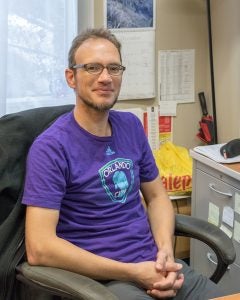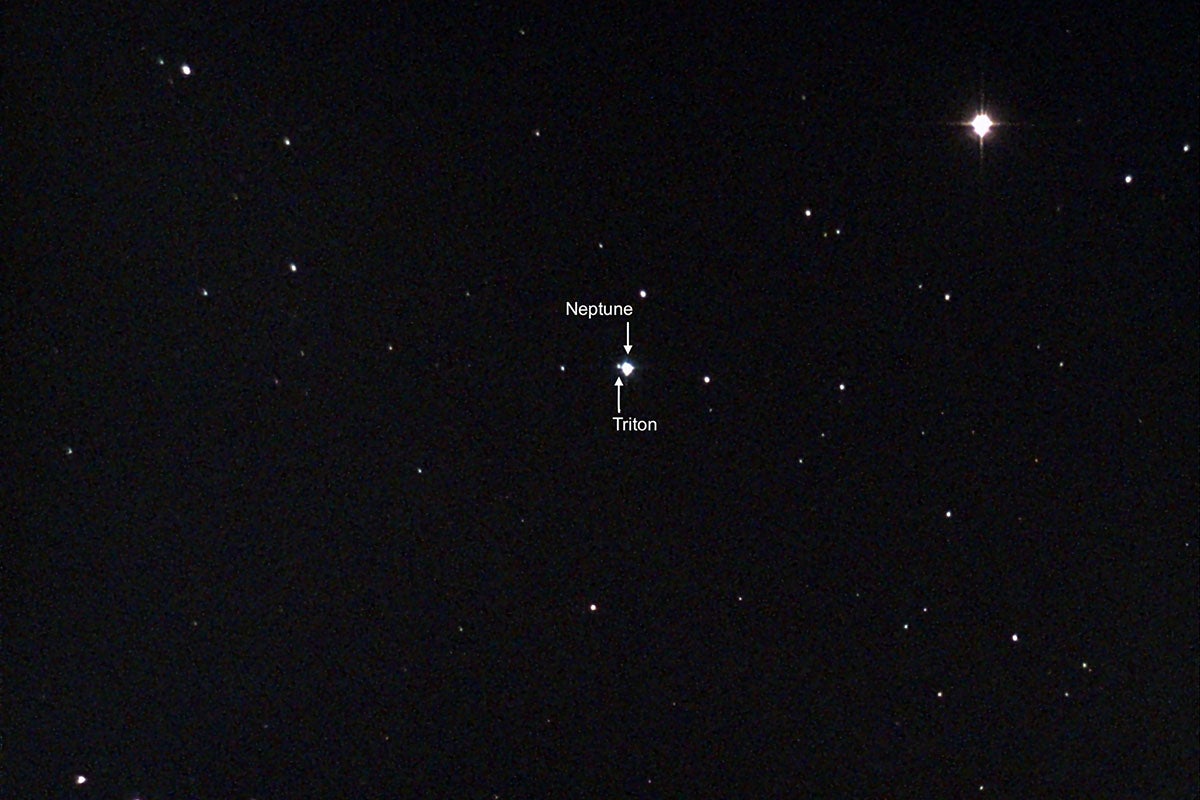Students and community members got a nice view of the planet Neptune and its biggest moon Triton during one of September’s Knights Under the Stars events hosted at UCF’s Robinson Observatory.
It was an early look at the planet, which today celebrates its 175th birthday.
“I did a Neptune project all the way back in my undergraduate days,” says Pegasus Professor of Physics Joseph Harrington, who specializes in exoplanets. “It was my first real astronomy project. Even today, it’s quite a mystery. There are several mission concepts out there and there’s a highly motivated group of astronomers pushing them, but there are no approved missions – yet.”

Despite the passage of time, the blue planet continues to captivate planetary scientists worldwide.
It is the narrowest of the gas giants and the furthest major planet out from the sun since Pluto was reclassified to a dwarf planet. Data from observations lead scientists to believe that Neptune is made up of gases and ice with a rocky core. Gravity is expected to be very close to what we experience on Earth because while Neptune has 17 times more mass than Earth, it is also four times larger than our planet. Distance is a challenge too. It would take about nine years to send a spacecraft to the planet with current technology.
There’s only been one flyby of the planet, completed by NASA’s Voyager 2 in 1989. It was a quick run and produced some stunning, but puzzling photos that left more questions than it answered.
The planet has also been studied from afar using the Keck, Hubble, and Spitzer telescopes, but it and its moon Triton still hold many secrets, says Assistant Professor of Physics Theodora Karalidi.
“Neptune … in a way, it is the closest thing we have to a brown dwarf in the solar system,” Karalidi says. “If finding life outside our planet is of interest, then exploring Neptune should be of interest. A ‘good’ atmosphere is important. The more we learn about atmospheres in our solar system, from the Earth to Venus, Mars, Jupiter, and Neptune, the more we can understand atmospheres and differentiate between a planet that can support life from one that cannot. By learning what the key features of different types of clouds, chemistry or atmospheric circulation patterns are in our observations from a distance, and how they compare with observations from up-close, we can make more informed decisions on which planets to stare at for longer periods to see if they have life, even when we have a single pixel to work with.”
Karalidi specializes in atmospheres of other planets. She’s eager to see what Neptune and Triton can tell us about life formation.

“Triton — one of the moons of Neptune — is an intriguing, active body that could host an ocean. This could make it a great location to search for life outside the Earth,” she says. “If it could host life, understanding Neptune would again be important. The magnetic field of Neptune for example, is weird but we don’t know why. As magnetic fields can be friends and foes to life, how could that affect life on Triton? Also, understanding the weird field of Neptune could also inform us about planetary magnetic fields in general, their interaction with solar wind and cosmic rays, and in extension our own magnetic field and our protection from those factors here on Earth.”
Neptune and Triton will remain visible with telescopes throughout winter. There are Knights Under the Stars events scheduled in October and again in November where the public can see these objects and others through several telescopes set up at the Robinson Observatory — at no cost. Participants also get a chance to ask questions and get some pointers from UCF faculty and students in the planetary sciences program.
“We love sharing the wonder of space,” says Yan Fernandez, a physics professor and director of the observatory. “That’s how a lot of us got into space related work. It was simply looking up and seeing how big it is out there and realizing we have so much to learn.”

Because of COVID19 Knights Under the Stars have limited capacity. To get more information and RSVP, visit the observatory’s website. Check out next month’s line up which includes participation in the International Observe the Moon Night on Oct.16.




